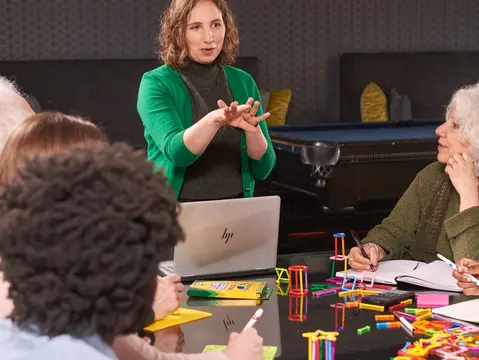top of page


See Ya Later, Silos! How Simple Activities Can Catalyze Collaboration
One of the most common culture challenges we hear from leaders is lack of cross-department collaboration. The dreaded silo effect. Silos are one example of “relational waste,” or causes of workplace waste or friction that stem from interpersonal dynamics. When colleagues don’t - or won’t - communicate and share information across departments you get missed deadlines, incomplete (or even inaccurate) deliverables, duplication of effort, turf battles, and sometimes pure animos
Nov 25


Why Play Works: An Explanation in One Venn Diagram
Employee engagement is a huge problem that has received a lot of attention in recent years. In their most recent report on the State of the Global Workplace, Gallup found that only 21% of employees are fully engaged at work. That means nearly 80% of employees are NOT fully engaged! Not only that, the year over year drop in engagement was most pronounced for managers, who set the tone for culture and morale across teams. Yikes! The consequences of continued low engagement are
Oct 29


What If All Your Conversations with Colleagues Were Positive?
In August, I delivered a keynote speech and workshop for the Michigan Lean Consortium about using play as a tool for continuous...
Oct 7


Making More Room for Introverts in Team Decision Making
One challenging dynamic that just about every team experiences at some point is the tension between introverts and extroverts. This...
Aug 25


Company Culture is Like AI: Garbage In? Garbage Out.
If there is one key takeaway from living through the last 10 years, it might be this: Beware the Algorithm. Every day we hear stories...
Aug 6


As AI Use at Work Increases, Culture Becomes More Critical
I have a confession to make: I am SO sick of hearing about AI. I’m tired of hearing people talk about it like it’s a magic panacea that...
Jul 23


Game Design Case Study: Decision-Making in Action
How do you get a room of 85+ people excited to practice collaborative decision making? You task them with inventing a game! This was the...
May 14


Play it Forward: A Movement for Meaningful Play
What if play wasn’t just something we did, but something we shared ? What if the laughter, learning, and human connection sparked in one...
May 8
Serious Results Through Play: What You'll Learn in the Play Facilitator Certification Program
I regularly meet practitioners, from independent facilitators and coaches to in-house HR and L&D leaders, who… are looking for ways to...
Apr 22


There's Nothing “Soft” about People Skills: 3 Reasons Why the Term Needs to Die
This may sound like a weird thing to have a very strong opinion about, but I despise the term “soft skills.” It’s a lazy, reductive, and...
Mar 25


Our Obsession with Efficiency is Going to Kill Us
It seems like every time I look at the news there’s an article about one of two huge disturbing trends: An obsessive drive for...
Feb 5


How Play Can Transform Teams and Break Down Barriers: Insights from the BizSouls Podcast
In a recent BizSouls podcast episode , I was asked a compelling question: How could opposing political parties, like the RNC and DNC, or...
Oct 24, 2024


How to Do Team-Building Right
I recently came across this Slate article by Alison Green (rightfully) criticizing many of the activities companies select in the name...
Oct 4, 2024


Why Game Facilitators are Important for Responsible Play
If you’ve been following our journey at Barometer XP, you’ve probably seen us promoting our Play Facilitator Certification program. Play...
Aug 16, 2024


Why Feeling Like You Belong at Work Matters: A Look at Identity and Belonging
In today’s dynamic work world, feeling like you belong is a game-changer for both employee happiness and company success. This idea kicks...
Jun 26, 2024


It’s OK to Play In Leadership Positions!
As a consultant, facilitator, and speaker who uses Play as her "secret weapon," I'm always amazed at how many people still dismiss its...
May 21, 2024


Why make more room for joy at work?
What pops into your mind when you think about work? I’m guessing it’s words like project, boss, meetings, or deadlines. Or maybe a mental...
Apr 13, 2024


Communication Skills: The Heartbeat of the Future Workplace
Picture this: You're navigating the digital landscape, armed with your technical prowess and data wizardry, when suddenly, a seismic...
Mar 14, 2024


Let’s be honest about all the things AI CAN’T do
You know how every time you crack open a newspaper or scroll through your news app, you're bombarded with headlines screaming about AI...
Mar 1, 2024


Fun is a Journey, Not a Destination
Well, it’s official. 2024 is fully underway. And I don’t know about you, but for me, there was no gentle easing into the new year. I went...
Jan 31, 2024
bottom of page